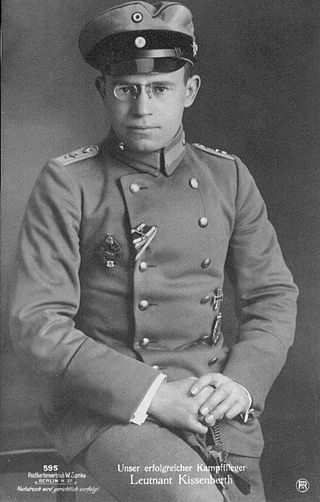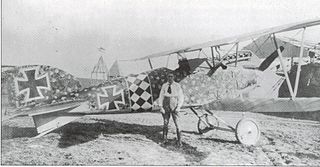
Hauptmann Wilhelm "Willi" Reinhard was a German pilot during World War I. Reinhard became a flying ace during the war, credited with 20 confirmed aerial victories. After commanding two successive fighter squadrons, he was picked to replace Manfred von Richthofen as commander of Jagdgeschwader 1 when the Red Baron fell in combat. Reinhard died on 3 July 1918 while testing a prototype fighter.

Otto Kissenberth was a German flying ace of World War I credited with 20 aerial victories. He was a prewar mechanical engineer who joined the German air service in 1914. After being trained and after serving as a reconnaissance pilot, he became one of the first German fighter pilots, flying with Kampfeinsitzerkommando KEK Einsisheim. He scored six victories with this unit as it morphed into a fighter squadron, Jagdstaffel 16. His success brought him command of Jagdstaffel 23 on 4 August 1917. He would run his victory tally to 20, downing his final victim using a captured British Sopwith Camel on 20 May 1918. Nine days later, a crash while flying the Camel ended Kissenberth's combat career. His injuries were severe enough he was not returned to combat, instead being assigned to command Schleissheim's flying school. Although Otto Kissenberth survived the war, he died soon after in a mountaineering accident on 2 August 1919.

Hans Kirschstein, winner of the Pour le Merite, Royal House Order of Hohenzollern, and the Iron Cross, 1st and 2nd class, was a German lieutenant and World War I flying ace credited with 27 aerial victories.
Leutnant Hermann Becker, was a World War I German flying ace credited with 23 victories.
StandartenführerLudwig Gaim was a World War I flying ace credited with five aerial victories. He ended the war as a Vizefeldwebel.
VizefeldwebelHermann Juhnke was a German World War I flying ace credited with five aerial victories.
Vizefeldwebel Richard Paul Rothe was a German World War I flying ace credited with five aerial victories.
Leutnant Karl Deilmann was a German World War I flying ace credited with six aerial victories.
OberleutnantErich Hahn was a World War I flying ace credited with six aerial victories.
VizefeldwebelAlfred Hübner was a World War I flying ace credited with six aerial victories.
Vizefeldwebel Max Kahlow was a German World War I flying ace credited with six aerial victories.
OffizierstellvertreterErich Schütze was a World War I flying ace credited with six aerial victories.
OffizierstellvertreterReinhard Treptow was a World War I flying ace credited with six aerial victories.
OffizierstellvertreterWilli Kampe was a World War I german flying ace credited with eight aerial victories.

VizefeldwebelFritz John Jacobsen was a German World War I flying ace credited with eight confirmed and two unconfirmed aerial victories.
LeutnantRudolf Klimke IC was a German World War flying ace credited with 17 confirmed and two unconfirmed aerial victories. Serving initially as a bomber pilot, his aggressiveness in bombing England, and in shooting down a couple of enemy airplanes got him reassigned to a fighter squadron. After a string of a dozen victories during 1918, he was wounded in action on 21 September 1918.

Oskar Hennrich was a German World War I flying ace credited with 20 aerial victories. He was a notable balloon buster, since thirteen of his wins were destructions of the observation balloons. He was the leading ace of his squadron, and ended his service with the rank of Vizefeldwebel.
Royal Prussian Jagdstaffel 38, commonly abbreviated to Jasta 38, was a "hunting group" of the Luftstreitkräfte, the air arm of the Imperial German Army during World War I. The unit would score 17 aerial victories during the war. The squadron's victories came at the expense of four losses, including one killed in action, one injured in a flying accident, and one wounded in action.
Royal Prussian Jagdstaffel 41, commonly abbreviated to Jasta 41, was a "hunting group" of the Luftstreitkräfte, the air arm of the Imperial German Army during World War I. The unit would score 73 aerial victories during the war, including ten observation balloons downed. The squadron's victories came at the expense of ten killed in action, two killed in flying accidents, three wounded in action, and one taken prisoner of war.
Royal Prussian Jagdstaffel 45, commonly abbreviated to Jasta 45, was a "hunting group" of the Luftstreitkräfte, the air arm of the Imperial German Army during World War I. The squadron would score over 113 aerial victories during the war, including 28 observation balloons downed. The unit's victories came at the expense of four pilots killed in action, two injured in flying accidents, and five wounded in action.





